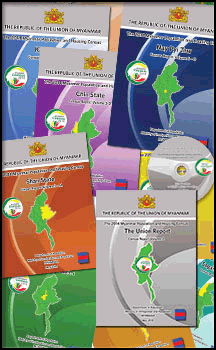They include detailed data on population size and growth, age and sex, marital status, migration, births and deaths, education, employment, disability, housing conditions and amenities in each state and region, district and township. Planners at all levels can use these to identify gaps and pinpoint needs for infrastructure and social services.
President U Thein Sein opened the launch event in the capital city. Over 1,000 guests attended, including chief ministers from all of the country’s 15 states and regions, ethnic and religious leaders, international donors, and representatives of UN agencies, international NGOs, civil society organizations and the private sector.
Vijay Nambiar, the UN Special Adviser for Myanmar, hailed the census as a “monumental achievement” that will benefit both the country’s development and its democratic process, despite challenges that need to be addressed.
A statement delivered on behalf of Dr. Babatunde Osotimehin, Executive Director of UNFPA, the United Nations Population Fund, said the results could help the Government and civil society “address disparities and inequalities across and within Myanmar society”.
Both speeches cited the unprecedented scale of the census exercise, organized by the Ministry of Immigration and Population with technical guidance from UNFPA and financial support from international donors. In just two weeks, over 100,000 enumerators visited nearly 11 million households, reaching nearly 98 per cent of the population.
They also noted that in Rakhine state, over 1 million people were not included in the enumeration exercise, amid ongoing communal tensions and the demand of many to self-identify as Rohingya, which the authorities did not allow, despite UNFPA’s advice. Other national surveys under way or planned will help to fill some of the resulting data gaps.
The reported total population of 51.5 million includes estimates for the areas not enumerated in Rakhine, and in Kachin and Kayin states, a total of 1.2 million people.
The census results reported in today’s launch show both progress since the last census in 1983 and ongoing challenges, including regional disparities and social indicators that lag behind Myanmar’s neighbours. Highlights include:
- Population growth, 0.89 per cent per year, is less than half the 1970s rate and slowing.
- There are only 93 males for every 100 females, reflecting significantly lower male life expectancy and higher migration by men.
- Half the population is under age 27, but the proportion of children has started to fall.
- The average number of children per woman has declined to 2.3 from 4.7 in 1983.
- Life expectancy at birth, 66.8 years, has improved but is still one of the lowest in South-East Asia. Life expectancy is six years longer for females than males.
- Infant and under-5 mortality rates are high nationwide (62 and 72 per 1,000 live births, respectively), and nearly twice as high in some states as in others.
- Almost 90 per cent of adults are literate, but in Shan state only 63 per cent are.
- 85 per cent of adult males and 50 per cent of females are in the workforce; unemployment is 4 per cent, and nearly twice as high for those 15-29.
- Only a third of households have electric lights and a third have mobile phones, but half have televisions.
- Over 70 per cent of homes have improved water and sanitation, but far fewer do in some states.
Additional results that require more time for analysis and consultation—on ethnicity, religion, occupation and maternal mortality—are scheduled for release next year.
The census main results are available online here.
For more information, contact:
- Yangon:
- Malene Arboe-Rasmussen, arboe-rasmussen@unfpa.org, +95 9 250 026 961
- Esther Bayliss, bayliss@unfpa.org, +95 9 260 991 218
- Bangkok:
- Roy Wadia, wadia@unfpa.org, +66 2 687 0111 or +66 84 875 2634
To download, Press release Myanmar version click here.


